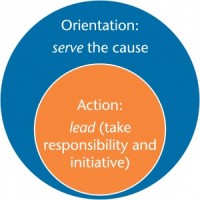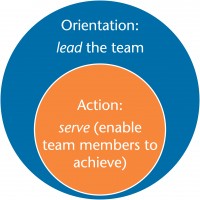Issue 2.3 | October 2010
In this Article: why a servant leader is not an oxymoron but a necessity.
by Jonathan Wilson
Martin, the new CEO, had arrived. In his radio show voice, he made a dynamic presentation to the organization charting a grand future. He promised to eliminate “dead wood” from the organization. He put up a sign on the campus pointing to the “CEO Office: This Way”. He renovated his office. Staff were excited. The organization needed the shot in the arm of a new, energetic leader. But the excitement was short-lived. Within two years Martin was fired, having brought his team to a grinding halt: the result of political in-fighting and strategic over-reach. The board, chastened, had to significantly rethink the kind of leader they would look for next time around.
In the eyes of many, the focal point of an organization is its leader. This is understandable, but misses the point. For a leader does not exist for himself: a leader is a servant. This well-worn but rich notion often suffers one of two fates: its meaning is diluted by those who prefer more to be served and less to be led; or it is denigrated by those who don’t understand how anyone can lead effectively if they’re also a servant. Both camps are stuck on the apparent contradiction of the terms “servant” and “leader”. A third understanding says that it embodies a paradox – that if Martin had been something of a servant and yet also something of a leader, he would have been a better CEO for it. But there is no paradox or contradiction. The words “servant” and “leader” are not opposing ideas. They are mutually distinct concepts that are both necessary to describe a fully orbed leader.
Leadership must be exercised in two directions – internally and externally. Martin’s catastrophic run as CEO lay in his failure to exercise servant leadership in either direction. The direction you face will determine what it looks like to serve, and what it looks like to lead.
Externally Directed Servant Leadership
The first and most important direction a leader faces is outward: as a leader, you exist for a cause. The cause is whatever problem your organization exists to solve. The team you lead exists, not for itself, but to serve the cause. For this reason, everything you do as a leader is defined by the cause. More precisely, in the end your cause is embodied in the customer – the recipient of your service. If you aren’t hearing it yet, let me make the language explicit. You and the team you lead are servants. You exist to serve other people.
for itself, but to serve the cause. For this reason, everything you do as a leader is defined by the cause. More precisely, in the end your cause is embodied in the customer – the recipient of your service. If you aren’t hearing it yet, let me make the language explicit. You and the team you lead are servants. You exist to serve other people.
Facing outward, leadership takes on three characteristics. Firstly, to lead is to recognize that there is a service that is needed, whether it be a solution, an innovation or a remedy. This is where vision, which we often associate with leadership, takes on its proper definition: true leadership vision is that which imagines a solution that betters the situation of a customer or potential customer, not the situation of the organization per se. Secondly, to lead is to take responsibility for the absence of a solution. Thirdly, to lead is to take the initiative to do something about the need that has been identified. Being aware of others’ problems, taking responsibility for the absence of a solution and taking initiative to create a solution are the qualities that set a leader apart from a follower. Followers blame others or circumstances for problems and therefore assume others should be responsible for their remedy. In Martin’s speeches, which focused on the glorious future of the organization, the customer and their world was conspicuously absent.
Internally Directed Servant Leadership
The second direction a leader faces is inward: to the team that exists to achieve the mission. As a leader, you exist to enable your people to achieve the cause. If your staff flourish in their abilities and personalities, your organization will be able to harness incredible human power in its mission to achieve its cause. A servant mentality will motivate you to draw on your team, listen to them, and invest in them. This is what it means to be a servant in team leadership: to enable your people to be all they can be. You exist for your staff – they do not exist for you. Whichever direction you face as a leader, you are a servant.
Looking inwardly, the cause defines the leadership you exercise for your team. You represent the cause to the team. To lead internally is to call the team to pursue the cause, remain true to the  cause, and achieve the cause with excellence. To lead internally is to manage personal and interpersonal needs and dynamics in light of the cause and the customer who embodies that cause. You have to exercise authority, but in service of the cause and in service of the success of your people. The cause defines who you hire, equip, and enable. It defines who you discipline or fire, because they are not best serving the cause, and therefore not best serving themselves.
cause, and achieve the cause with excellence. To lead internally is to manage personal and interpersonal needs and dynamics in light of the cause and the customer who embodies that cause. You have to exercise authority, but in service of the cause and in service of the success of your people. The cause defines who you hire, equip, and enable. It defines who you discipline or fire, because they are not best serving the cause, and therefore not best serving themselves.
Within this framework we can see how the qualities of “servant” and “leader” are not in opposition to each other. The characteristics we typically associate with the “servant” part of a servant leader – humility, compassion, dedication to others – work naturally alongside those we typically associate with being a “leader” – vision, courage, discipline, authority. To notice problems requires a servant. To respond to problems requires a leader. To solve problems requires a team. To lead a team requires a servant.
Are you a servant leader?
Another soul insight from www.soulsystems.ca.
Leadership by Soul™, Trademark and © Soul Systems, All Rights Reserved.

